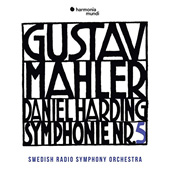

Rarely have I heard the few opening measures of this symphony unleashed with such oppressively inexorable force, and its final minutes infused and driven by such ecstatic euphoria, with everything in between shaping the radical transformations that link the two extremes. After all the Symphony No. 5 in C-sharp minor by Gustav Mahler (1860-1911) is an expansive epic journey 'per aspera ad astra' ('through hardship to the stars') from fears of oppressive intolerance to great feelings of overwhelming joy. I've always understood this symphonic work's extra-musical context as being suggested by movements -(1): Mahler's forewarning vision of the political and military violations to befall the Austrian jews a few years hence (what else in Mahler's music sounds as Jewish as the plaintive main subject of the first movement) -(2): the conflicts arising from these acts of transgression, -(3): the ambivalent coexistence of the 'common' folk lšndler and the 'elite' aristocratic waltz under the same roof, -(4): the love and compassion that could bring an end to all this, and -(5): the coming together of all concerned towards a common objective (notice how the first instrument takes its cue from the last note of the fourth movement, echoed by other various instruments until all of them join together and lead the way to a jubilant finale).
We have been following conductor Daniel Harding's excursions into Mahler territory very closely, and so far have been highly impressed. His account of the No. 10 on Deutsche Grammophon, the No. 6 on BR-Klassik, and recently the No. 9 from his new venture on Harmonia mundi, have all revealed intrinsic and rather important details within the scores hitherto missed or ignored by other conductors. For example how finely he delineates the strands of the first movement's main theme and in doing so brings the counter-melody closer to the surface. And at the very end of the same movement, how the rumbling percussion between the rising trumpet calls sounds so much like distant bombardment. How well he brings out the sorrowfulness within the passage for low strings beginning at the 4:32 mark of the second movement. The central Scherzo movement is the 'core' of the symphony as it outlines the dichotomy that divides the two polar extremes that begin and end this symphony. When Harding drives the 'waltz' into a frenzy around the 11:00 mark it opens the door to ensuing conflict, which further exposes the two opposite ideologies, until in the end, Harding whips up the opening 'lšndler' horn call into such a high state of delirium that the members of the Swedish Radio Symphony Orchestra can barely hold it together. Harding's slightly faster Adagietto movement at just over ten minutes, when compared to Bernstein or Karajan for example, does not so much pull at the heartstrings as demonstrate how deep of an emotional chasm exists between it, and its preceding and following movements, which led early critics of this symphony to label it as "schizophrenic". But from the 8:00 point on, Harding's deep empathy for the music may still manage to choke you up. Camouflaged within the fabric of the final movement are quotes from Mahler's own 'Resurrection' symphony, intertwined with energized recapitulations of material from the preceding movements, which is what gives this movement such a dramatic uplift. And like I mentioned earlier, Daniel Harding and the musicians push the final few moments to such a euphoric level, it will make your day.
I've heard so many recordings of Gustav Mahler's music throughout my life that I've lost count, so you would think that I've reached a saturation point. Well, when the conductor captures the innermost 'pneuma' of the composer, and the orchestra projects it so well, I for one can't wait for any of their ensuing releases.
Jean-Yves Duperron - October 2018